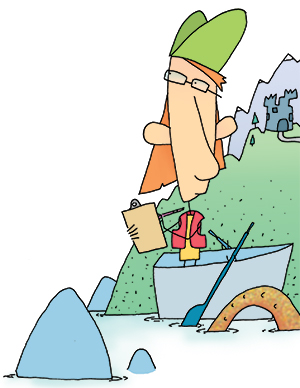Warm-Up for Personal Narratives
When we tell stories about things that happen to us, we share what makes us unique. You can connect with others by writing a personal narrative.
What Is a Personal Narrative?
Listen to "What Is a Personal Narrative?"
Hide audio

A personal narrative is a true story about a specific time in your life. Whenever friends get together, they like to share their experiences: “Guess what happened to me?” Sharing experiences makes life better for everyone—from classmates and teammates to family members and neighbors. By talking about what is going on in their lives, people connect with each other.
In this unit, you will write a personal narrative about an experience that taught you something about yourself. You need to select an experience that would interest and maybe even amaze your friends. Just follow the directions in the unit and use your natural storytelling ability.
Thinking About Sensory Details
You can bring a story to life with sensory details. Sensory details let the reader see, hear, smell, taste, and touch the experience—that is, live it. When you plan your own personal narrative, think carefully about what you sensed during the experience. Record your notes in a sensory chart. Here's a sample paragraph, followed by a sensory chart with details that bring the description to life.
Narrative Paragraph
The rumbling grew as our raft bobbed toward the drop in the river. The air moistened and smelled of morning dew. Ahead of us, copper water plunged off a set of boiling rapids, which carved their curving way among jagged cliffs. My mouth went dry with a tang of fear. “Hold on, everybody!” I shouted.
Sensory Chart
|
Sights |
Sounds |
Smells |
Tastes |
Textures |
|
Copper water Curving river Jagged cliffs |
Rumbling Boiling “Hold on, everybody!” |
Morning dew |
Tang of fear |
Bobbing raft Moist air Dry mouth |
|
Sights |
Copper water Curving river Jagged cliffs |
|
Sounds |
Rumbling Boiling “Hold on, everybody!” |
|
Smells |
Morning dew |
|
Tastes |
Tang of fear |
|
Textures |
Bobbing raft Moist air Dry mouth |
Fill in a sensory chart.
Take a moment to think about something fun or exciting that you did or experienced recently. Consider the sights, sounds, smells, tastes, and textures of the moment. What details would readers need to know to experience the event? Fill in the sensory chart with specific details. Make a copy of this Google doc or download a Word template.
|
Sights |
Sounds |
Smells |
Tastes |
Textures |
|
|
|
Sights |
|
|
Sounds |
|
|
Smells |
|
|
Tastes |
|
|
Textures |
Teaching Tip
Let your students know that not all the senses need to be explained in their narratives. However, they should search for opportunities to provide readers with a vivid, sensory experience.